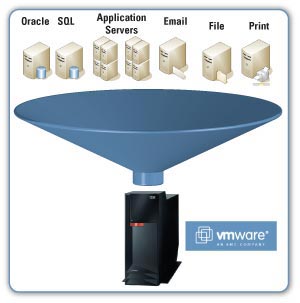Five tips start with virtualizing the server
Virtualization - a move from the real world, physical hardware to virtual hardware - is becoming one of the next major development trends in the IT industry. There are now more virtualized options in each area for selected IT professionals, such as the open source applications of Xen and Virtual Iron, or Microsoft's Virtual Server with rapid growth and respected VMware products.
But not everyone is familiar with virtualization technology. If you are new, you probably won't know how to start with these products. The following content will introduce and help you some easier access to virtualization programs and procedures. (Can refer to some documents on VMware - explanation of virtualization with basic terms).
1. Determine if you have enough servers to merge
 The first reason when it comes to hardware consolidation is virtualization. Old hardware, data center overflow, power loss, etc. are some typical problems that exist in physical devices. These virtual devices do not have these phenomena. It is for this reason that virtualization technology is promoted and enhanced, growing rapidly. There is no reason for you to use separate physical machines when you can convert them into real servers at a ratio of 3, 4, 5, even in some cases 10 individual machines = 1 server.
The first reason when it comes to hardware consolidation is virtualization. Old hardware, data center overflow, power loss, etc. are some typical problems that exist in physical devices. These virtual devices do not have these phenomena. It is for this reason that virtualization technology is promoted and enhanced, growing rapidly. There is no reason for you to use separate physical machines when you can convert them into real servers at a ratio of 3, 4, 5, even in some cases 10 individual machines = 1 server.
The first step in getting familiar with virtualization is to determine whether you have the right kind of support infrastructure. If you have multiple machines that do the same job, they should be virtualized. The number of suitable conversion servers is also important, usually 10 or less. With more than 10 servers, the benefits will be greater.
2. Eliminate the headache of administrative problems
Any major conversion, such as server consolidation or large-scale deployments, has a significant impact on some internal programs. You need to use or request support from a good technician from the manufacturer, receiving a trade management program. You also need to invest money when moving to virtualization services, because the cost is quite expensive, and dealing with human resources. When physical servers are reduced, of course the budget will also change and the head of the organization must reorganize the human resources accordingly. You also need to anticipate the workload and impact generated when there is less physical server but more virtual server, need to calculate the amount of work and time required for each department.
Also need to check the necessary copyright. Depending on the software you are using on your virtual machines and their configuration, you may need to adjust some of the licenses and buy some more for new CPUs or base users.
3. Choice of hardware and software
There are several virtualization products on the market for you to choose from. Their prices are very different, in which Microsoft Virtual Server and VMware's VMware Server are free.
Larger applications such as ESX Server or Xen product line have higher price, which means more components and better performance. The specific price depends on the configuration you choose: simple server consolidation, advanced host or network configuration functions. Some firms also offer 'starting tools', which allow you to test and explore technology at relatively low prices.
4. Start to virtualize
 A beautiful day, after months of preparation and planning, you began to really move from physical technology to virtualization. Consider some of the synthesis tools below, which will help you. Microsoft, in the near future will release the product that allows to convert the entire server installed, running Windows version to support virtual hard drive format to Virtual Server product support. VMware has put a tool with similar functionality into operation. These integrated utilities can save you hours of time, if not daily, to make real conversions.
A beautiful day, after months of preparation and planning, you began to really move from physical technology to virtualization. Consider some of the synthesis tools below, which will help you. Microsoft, in the near future will release the product that allows to convert the entire server installed, running Windows version to support virtual hard drive format to Virtual Server product support. VMware has put a tool with similar functionality into operation. These integrated utilities can save you hours of time, if not daily, to make real conversions.
Some other components to consider :
• Use advanced cluster functions in groups . Using clusters with advanced execution capabilities gives your virtual machine higher availability, while improving performance.
• Pay attention to management issues . How will your staff manage the collection of virtual machines? What support does your virtual server software support scripting languages and APIs? Can you access certain controls via the command line to manage simple remote access?
• Don't forget the storage issue . You will need a small disk system with very fast speed to get the fastest performance for virtualization servers. Usually the most popular currently is iSCSI standard disks. They are reasonably priced with great configuration capabilities, and fast.
5. Monitoring, evaluation, interruption and improvement
With any ongoing program, it's important to keep tabs on the virtual project when starting to switch users and services to the new platform. You need to set up some implementation guidelines and manuals, set up a number of starting points, evaluate the meaning they provide for interrupting and improving in the future. Consider disconnected hardware configurations, network settings or increase bandwidth width if necessary. Your job is not just to boot the virtualized operating system for the last time, but also to consider many other factors.
You should read it
- How to set up a virtual server
- 4 free virtualization software solutions on Windows
- Things to know about the new Virtual Server
- Set up virtualization server
- Virtualization realization
- Install Hyper-V Virtualization on Windows Server 2008 R2
- Back up virtual machines with Windows Server 2008 R2 and Hyper-V
- 10 common errors in virtualization
May be interested
- Network basics: Part 3 - DNS Server
 a dns server is a server that contains a database of public ip addresses and hostnames associated with them. in most cases, the dns server is used to resolve or translate those common names into ip addresses as required.
a dns server is a server that contains a database of public ip addresses and hostnames associated with them. in most cases, the dns server is used to resolve or translate those common names into ip addresses as required. - Career tips from 14 tech heroes
 you can use a lot of valuable advice from people who have been ahead (and have been successful) that you see every day by looking at their interviews and talks. their advice is often concise and profound, and if you listen to it, you may save a lot of time, money and unnecessary stresses in the start-up process.
you can use a lot of valuable advice from people who have been ahead (and have been successful) that you see every day by looking at their interviews and talks. their advice is often concise and profound, and if you listen to it, you may save a lot of time, money and unnecessary stresses in the start-up process. - Discover EMC in Exchange Server 2010 (Part 2)
 in the previous article, we learned some new features in exchange server 2010, including: high availability, archiving, federation and sharing.
in the previous article, we learned some new features in exchange server 2010, including: high availability, archiving, federation and sharing. - How to fix Pin to Start error on Windows 10
 to pin any file to the start menu bar, you'll use the pin to start option. thus, we can access files and programs on the computer faster. but, what if i lost pin to start?
to pin any file to the start menu bar, you'll use the pin to start option. thus, we can access files and programs on the computer faster. but, what if i lost pin to start? - Create Start button on Windows 8
 the disappearance of the start button on the windows 8 desktop makes many users unhappy and a little confused when using. therefore, there are quite a number of start button initialization applications that we introduced below to help users feel comfortable using this operating system.
the disappearance of the start button on the windows 8 desktop makes many users unhappy and a little confused when using. therefore, there are quite a number of start button initialization applications that we introduced below to help users feel comfortable using this operating system. - Tips or help you master the Start Menu on Windows 10
 the start menu is one of the highlights of the windows 10 operating system. in particular, the start menu on windows 10 is more customizable than other operating systems.
the start menu is one of the highlights of the windows 10 operating system. in particular, the start menu on windows 10 is more customizable than other operating systems. - Tips to keep your Ubuntu Linux server secure
 as a system administrator, one of your key tasks is to handle server security issues. if your server is connected to the internet, you should place it in the conflict zone. if it's just an internal server, you still need to handle it (maybe one way
as a system administrator, one of your key tasks is to handle server security issues. if your server is connected to the internet, you should place it in the conflict zone. if it's just an internal server, you still need to handle it (maybe one way - How to set up your own Git server on Linux
 while you can count on globally renowned git hosting services like github, in some cases it is better to host a personal git server for enhanced privacy, customizability, and security.
while you can count on globally renowned git hosting services like github, in some cases it is better to host a personal git server for enhanced privacy, customizability, and security. - 18 start-up mistakes from Y Combinator founder (part 2)
 choose the wrong platform, launch the product at the wrong time and the irrational spending is the startup killing cause given in this section.
choose the wrong platform, launch the product at the wrong time and the irrational spending is the startup killing cause given in this section. - Use IIS to set up FTP Server on Windows
 set up an ftp server (file transfer protocol server) to share and convert large files with unlimited traffic.
set up an ftp server (file transfer protocol server) to share and convert large files with unlimited traffic.










 Google free mail server, website for Vietnamese universities
Google free mail server, website for Vietnamese universities Vista will interact with Longhorn Server
Vista will interact with Longhorn Server 10 incredible keyboards
10 incredible keyboards USB memory stick and memory card reader
USB memory stick and memory card reader How dangerous is Skype?
How dangerous is Skype? Some methods help save printing costs
Some methods help save printing costs